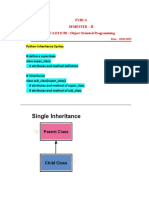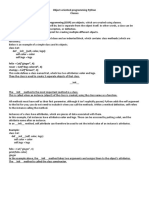0 ratings0% found this document useful (0 votes)
37 viewsOOP in Python - Inheritance
This document discusses object-oriented programming concepts in Python including inheritance, polymorphism, and child and parent classes. It defines a Dog class and several subclasses (JackRussellTerrier, Dachshund, Bulldog) that inherit from Dog. It creates instances of the subclasses and demonstrates that they are instances of both their own class and the parent Dog class. The document also shows how to override and call methods from the parent class. Finally, it provides an example of creating a child window using a Toplevel class in Tkinter.
Uploaded by
Garuma AbdisaCopyright
© © All Rights Reserved
We take content rights seriously. If you suspect this is your content, claim it here.
Available Formats
Download as DOCX, PDF, TXT or read online on Scribd
0 ratings0% found this document useful (0 votes)
37 viewsOOP in Python - Inheritance
This document discusses object-oriented programming concepts in Python including inheritance, polymorphism, and child and parent classes. It defines a Dog class and several subclasses (JackRussellTerrier, Dachshund, Bulldog) that inherit from Dog. It creates instances of the subclasses and demonstrates that they are instances of both their own class and the parent Dog class. The document also shows how to override and call methods from the parent class. Finally, it provides an example of creating a child window using a Toplevel class in Tkinter.
Uploaded by
Garuma AbdisaCopyright
© © All Rights Reserved
We take content rights seriously. If you suspect this is your content, claim it here.
Available Formats
Download as DOCX, PDF, TXT or read online on Scribd
You are on page 1/ 3
############## ## Notice that isinstance() takes two
arguments, an object and a class.
class Dog:
print(isinstance(miles, Bulldog)) # False
species = "Canis familiaris"
## More generally, all objects created from a
def __init__(self, name, age): child class are
self.name = name ## instances of the parent class, although they
self.age = age may not be
def __str__(self): ## instances of other child classes.
return f"{self.name} is {self.age} years old" print(buddy.speak("wooo")) # Buddy barks:
wooo
def speak(self, sound):
print(miles.speak()) # Miles says Arf
return f"{self.name} barks: {sound}"
print(miles.speak("Grrr")) # Miles says Grrr
class JackRussellTerrier(Dog):
# changes to the parent class automatically
def speak(self, sound="Arf"): propagate to child
return f"{self.name} says {sound}" #classes as long as the attribute or method
being changed isn’t
class Dachshund(Dog):
#overridden in the child class.
pass
#########################
class Bulldog(Dog):
class Dog:
pass
species = "Canis familiaris"
miles = JackRussellTerrier("Miles", 4)
def __init__(self, name, age):
buddy = Dachshund("Buddy", 9)
self.name = name
jack = Bulldog("Jack", 3)
self.age = age
jim = Bulldog("Jim", 5)
def __str__(self):
print(miles) # Miles is 4 years old
return f"{self.name} is {self.age} years old"
print(miles.species) # Canis familiaris
def speak(self, sound):
print(type(miles)) # <class
'__main__.JackRussellTerrier'> return f"{self.name} barks: {sound}"
print(isinstance(miles, Dog)) # True class JackRussellTerrier(Dog):
def speak(self, sound="Arf"): # changes to the parent class automatically
propagate to child
return super().speak(sound) # parent class
format of speak is used #classes as long as the attribute or method
being changed isn’t
class Dachshund(Dog):
#overridden in the child class.
pass
#########################
class Bulldog(Dog):
class Dog:
pass
species = "Canis familiaris"
miles = JackRussellTerrier("Miles", 4)
def __init__(self, name, age):
buddy = Dachshund("Buddy", 9)
self.name = name
jack = Bulldog("Jack", 3)
self.age = age
jim = Bulldog("Jim", 5)
def __str__(self):
print(miles) # Miles is 4 years old
return f"{self.name} is {self.age} years old"
print(miles.species) # Canis familiaris
def speak(self, sound):
print(type(miles)) # <class
'__main__.JackRussellTerrier'> return f"{self.name} says {sound}"
print(isinstance(miles, Dog)) # True class GoldenRetriever(Dog):
## Notice that isinstance() takes two def speak(self, sound="Bark"):
arguments, an object and a class.
return super().speak(sound)
print(isinstance(miles, Bulldog)) # False
buddy = GoldenRetriever("Buddy", 9)
## More generally, all objects created from a
child class are print(buddy.speak()) #Buddy says Bark
## instances of the parent class, although they ####################
may not be Tkinter child window (using class)
## instances of other child classes. from tkinter import Button, Tk, Toplevel
print(buddy.speak("wooo")) # Buddy barks: class App(Tk):
wooo
def __init__(self):
print(miles.speak()) # Miles says Arf
super().__init__()
print(miles.speak("Grrr")) # Miles says Grrr
self.geometry('300x200')
self.title('Main Window')
# place a button on the root window
Button(self,
text='Open a window',
command=self.open_window).pack(expand=Tr
ue)
def open_window(self):
window = Window(self)
window.grab_set()
class Window(Toplevel):
def __init__(self, parent):
super().__init__(parent)
self.geometry('300x100')
self.title('Toplevel Window')
Button(self,
text='Close',
command=self.destroy).pack(expand=True)
if __name__ == "__main__":
app = App()
app.mainloop()
You might also like
- Class 3 To Class 5 Python OOPs ConceptsNo ratings yetClass 3 To Class 5 Python OOPs Concepts33 pages
- Python Object-Oriented Programming (OOP) : TutorialNo ratings yetPython Object-Oriented Programming (OOP) : Tutorial11 pages
- Object-Oriented Programming in Python OverviewNo ratings yetObject-Oriented Programming in Python Overview13 pages
- Understanding_Object_Oriented_Programming_in_Python_SlidesNo ratings yetUnderstanding_Object_Oriented_Programming_in_Python_Slides28 pages
- Data Science With Python - Intermediate Level V2.0No ratings yetData Science With Python - Intermediate Level V2.0153 pages
- Chap 5 - Object Oriented Programming in PythonNo ratings yetChap 5 - Object Oriented Programming in Python8 pages
- Learn Python 3 - Classes Cheatsheet - CodecademyNo ratings yetLearn Python 3 - Classes Cheatsheet - Codecademy6 pages
- Python OOP (Object Oriented Programming) ?No ratings yetPython OOP (Object Oriented Programming) ?13 pages
- What are some important differences between a string and a list in PythonNo ratings yetWhat are some important differences between a string and a list in Python1 page
- (L7)Programming with Python (Intermediate Level)No ratings yet(L7)Programming with Python (Intermediate Level)31 pages
- 3.classes: 3.1. Python Scopes and NamespacesNo ratings yet3.classes: 3.1. Python Scopes and Namespaces10 pages
- The Big Book of Pet Names ~ More than 10,000 Pet Names! The Most Complete Guide to Pet Names & MeaningsFrom EverandThe Big Book of Pet Names ~ More than 10,000 Pet Names! The Most Complete Guide to Pet Names & MeaningsNo ratings yet
- ANCOVA How To Perform An Ancova in PythonNo ratings yetANCOVA How To Perform An Ancova in Python4 pages
- Схема и Сервис Мануал На Английском Sony Kdl-24r400a Шасси Rb1fk 9-883-556-51No ratings yetСхема и Сервис Мануал На Английском Sony Kdl-24r400a Шасси Rb1fk 9-883-556-5140 pages
- Ystem Rogramming: Laboratory Manual and Work Book100% (1)Ystem Rogramming: Laboratory Manual and Work Book70 pages
- On Portal User Manualand Training Guide Rev 3No ratings yetOn Portal User Manualand Training Guide Rev 395 pages
- Tipos de Adverbios Que Existen, Tabla Comparativa Sem 6No ratings yetTipos de Adverbios Que Existen, Tabla Comparativa Sem 63 pages
- [FREE PDF sample] Handbook of Water and Wastewater Treatment Plant Operations 3rd Edition Frank R. Spellman ebooks100% (3)[FREE PDF sample] Handbook of Water and Wastewater Treatment Plant Operations 3rd Edition Frank R. Spellman ebooks41 pages
- Diebold Nixdorf Series 490A Product CardNo ratings yetDiebold Nixdorf Series 490A Product Card2 pages
- 01 Lab Manual COMRO1 - Programming BasicsNo ratings yet01 Lab Manual COMRO1 - Programming Basics6 pages
- Perl - How To Use Getopt - Long Method - Stack Overflow PDFNo ratings yetPerl - How To Use Getopt - Long Method - Stack Overflow PDF3 pages
- Honors Advanced Calculus and Linear Algebra p2No ratings yetHonors Advanced Calculus and Linear Algebra p22 pages
- OTS Structured Cabling Installation Checklist (1) 2No ratings yetOTS Structured Cabling Installation Checklist (1) 23 pages
- Server Base System Architecture v3 1 Arm DEN 0029ANo ratings yetServer Base System Architecture v3 1 Arm DEN 0029A59 pages




























































































